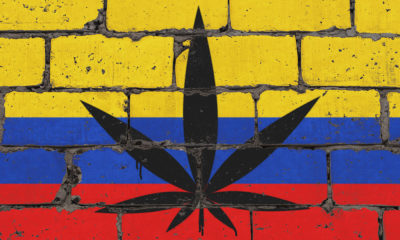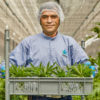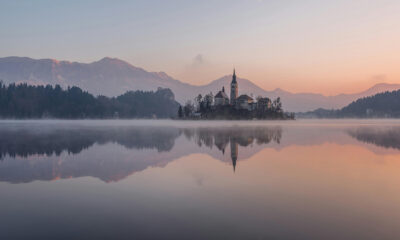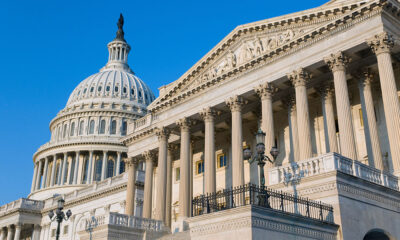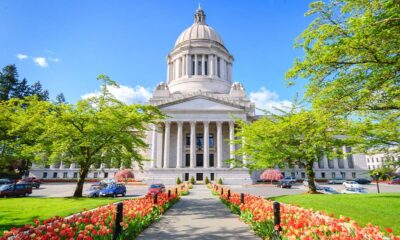
Politics
Colombian Cannabis Cultivators Face Continued Crackdown
Colombia is at a crossroads with the historic election of the left-populist Gustavo Petro as president. But will he be able to close the country’s cannabis gap? Big Bud is booming, while small peasant producers face continued eradication.
The outcome of the June 19 presidential run-off race in Colombia was going to be unprecedented either way, as it pitted two political “outsiders” who ran anti-establishment campaigns against each other. But the victor, progressive senator (and ex-guerilla leader) Gustavo Petro, made it doubly unprecedented—as he’s now set to become the country’s first president of the left.
Petro won a narrow victory over rival right-wing populist Rodolfo Hernández, a pugnacious construction magnate in the mold of Donald Trump. The pair represented diametrically opposed brands of populism. Petro’s campaign emphasized multiculturalism and ecology as well as more traditional leftist demands for social and economic justice. His running mate Francia Márquez, an Afro-Colombian environmental campaigner, will become the country’s first Black vice president after the Aug. 7 inauguration.
“This story that we’re writing today is a new story for Colombia, for Latin America, for the world,” Petro said in his victory speech at a Bogotá arena. “We’re not going to betray this electorate.”
But despite progress in recent years—a peace process to wind down the internal war, emergence of a legal cannabis sector—Colombia’s drug-war dystopia remains deeply entrenched. Petro will face a challenge in lifting the pressure on small peasant cannabis producers, who have largely been left behind as big greenhouse operations dominate the legal industry.
Corporate or Campesino Cannabis?
The good news is that there is now a consensus on legalized commercial cannabis cultivation nearly across Colombia’s political spectrum. Medical marijuana was legalized in December 2015 by decree of then-president Juan Manuel Santos—who would the following year win the Nobel Peace Prize for negotiating peace with the FARC guerillas. Along with the peace deal, 2016 also saw Colombia’s Congress approve commercial cultivation.
Even Santos’ hardline successor, outgoing incumbent Iván Duque, who rejected the peace deal and bottlenecked its implementation, has embraced a commercial cannabis sector. This Feb. 20, Duque signed Resolution 227, expanding commercial licenses and approved uses of cannabis in foods and beverages. He also announced his support for legislation to allow exports.
And this program was enthusiastically embraced by both Petro and Hernández.
Hernández went so far as to say that cannabis could become the “motor” of Colombia’s economy, noting the “great quantity of foreign investment” the sector has received. His campaign cited a study by Colombian think-tank Fedesarrollo finding that cannabis could generate exports of more than $1.7 billion by 2030.
However, on the ongoing armed conflict and narco-violence, Hernández took an extreme hardline position, pledging a “zero impunity” approach to crime. He said he would declare a state of emergency upon taking office and order the security forces to retake areas “where armed actors exercise political and territorial control.”
Petro, in contrast, says he’ll reform the security forces and purge their leadership at the highest levels. He calls the “war on drugs” a failure, and pledges to re-focus enforcement efforts from peasant producers and low-level couriers to the financial and business sectors that facilitate trafficking and launder the proceeds.
And this points to likely differences in their approach to cannabis. Unlike Hernández, Petro didn’t emphasize expanding the cannabis sector as a platform plank. However, when asked about it in an interview with Bogotá newsweekly Semana in March, he responded frankly: “It seems stupid to me to keep marijuana underground, so that the sons of former presidents are entering the business of legal marijuana exportation, while they drop bombs on the campesinos and their sons who produce marijuana in Cauca.”
The southwestern region of Cauca is the traditional heartland of illicit cultivation in Colombia, and hardly coincidentally, one of the regions most impacted by the ongoing armed conflict.
The interviewer pressed Petro on which son of an ex-president is entering the cannabis industry, but he wouldn’t name names. However, rumors reported by the Colombian media have named Martín Santos, son of the former president, as seeking a stake in a prospective cannabis producer called Metódica Consulting.
And certainly the foreign investors hyped by Hernández have poured money into large-scale facilities in the immediate environs of Bogotá—far from peasant production zones of hinterlands like Cauca, where entirely too little has changed.
Eradication, Counterinsurgency Operations Continue
Campesino cannabis cultivation in Cauca remains almost entirely unlicensed—which means the producers have no choice but to sell to criminal networks, which overlap with the armed factions. This, of course, makes them targets for counterinsurgency, as well as ongoing eradication efforts.
On May 11, the army uprooted two cannabis plots in a raid at the hamlet of El Mayo, Toribío municipality, in the Nasa indigenous zone of Cauca. Troops arrived at the remote mountain hamlet by helicopter to seek out illegal crops and found what they were looking for.
The hamlet was visited a few days later by Colombian news site Las 2 Orillas. One local resident told the reporter that the impacted families will go hungry, “since the marijuana plantations are their only means of sustenance or survival.”
Mónica Díaz, a peasant leader in the municipality, emphasized that the local communities have essentially been abandoned by the government—except when it sends in soldiers to eradicate crops. “The army doesn’t agree with us cultivating these plants, but it’s the only way, because the government doesn’t collaborate with us,” she said. “It’s our only form of sustenance.”
About a month later, on June 13, the armed forces announced the killing of guerilla leader Leider Yohani Noscué, AKA “Mayimbú” or “Comandante Wilson,” in the Cauca municipality of Suárez. He was commander of the FARC’s Sixth Front, which has remained in arms, in rejection of the 2016 peace accord. The military said Mayimbú was killed in an anti-guerilla operation code-named “Jaguar.” His body wasn’t recovered, but the Sixth Front confirmed his death and released photos of his coffin, draped in the Colombian flag, being lowered into a grave at a clandestine mountain location.
Media accounts made much of Mayimbú’s supposed control of cannabis cultivation in Cauca’s “Golden Triangle”—defined by the municipalities of Miranda, Corinto and Toribío. There was the familiar sensationalism about new and supposedly ultra-potent strains, with the traditional Punto Rojo purportedly being replaced by “Creepy” (also rendered “Cripy”). Authorities estimate 13,000 hectares are dedicated to unlicensed cannabis cultivation in Cauca’s Golden Triangle.
And anger is rising fast at the continued eradication of illicit crops as fortunes are made in the corporate cannabis sector. On the same day as the raid on El Mayo, May 11, three campesinos were wounded in San José de Uré, Córdoba region, when local residents reacted angrily to a National Police detachment sent in to eradicate their coca crops. “The community was protesting peacefully, without arms, when the police utilized arms of the state to fire on the civil population,” José David Ortega, leader of the Campesino Association of the Sur de Córdoba told newspaper El Espectador.
A similar incident was reported May 9 at Jamundí in Valle del Cauca (the next region to the north of Cauca), where local residents gathered to angrily protest a detachment of army troops sent in on an eradication mission. Media accounts did not mention any casualties or make clear if the crops in question were cannabis or coca. Also in May, campesinos at Tibú, Norte de Santander, blocked roads to prevent army troops from entering their communities to eradicate coca crops.
In April, the Campesino, Cocalero, Agrarian & Environmental Movement of Putumayo (MOVICAAP) launched a protest campaign in that southern rainforest region to bring attention to “the grave conditions we suffer in our territories, generated by forced eradication of coca-leaf crops, abandonment by the state, and systematic violation of human rights.”
The Specter of Fumigation
A particular threat of backsliding deeper into eradicationist dystopia is the return of aerial spraying of the herbicide glyphosate on illicit crops—fumigation, as it’s called by the government. Initiated in the 1980s, this was suspended in 2015 due to health concerns, and amid legal challenges to the practice by impacted campesino communities. The US stopped sending contract pilots for the spraying in 2013, after planes were shot down by the guerillas.
But Duque revived the fumigation program in 2018, this time on a smaller scale and carried out by drone rather than bush-plane, supposedly allowing for more precise targeting. In April 2021, Duque signed Decree 380, establishing regulations for expansion of the spraying. The text of the decree specifically mentioned “marijuana” as well as coca crops.
This May, the newly formed National Coordinator of Coca, Opium & Marijuana Producers (COCCAM) held a meeting in the city of Cúcuta, where they resolved to call a nationwide strike if the government implements Decree 380. And this April, more than 20 Colombian civil society organizations, including Dejusticia and Elementa, wrote to the Inter-American Commission on Human Rights (IACHR), petitioning for an official audience to testify against the resumption of glyphosate spraying.
The Special Jurisdiction for Peace (JEP), the body established by the 2016 accords to try cases related to the armed conflict, is currently hearing its first case concerning communities impacted by glyphosate spraying. The complaint was brought by a group of campesinos from villages in the Bolívar region, represented by the Association of Agricultural Producers of the Zona Alta de San Pablo (ASOCAZUL). Litigants say that at least 40 farmers who weren’t even producing illegal corps were impacted by the spraying, both affecting their health and destroying their (legal) crops, such as cacao.
By 2020, a total of 263 similar complaints had been brought before Colombia’s ordinary courts, demanding reparations. Of these, 41 were found in favor of the impacted communities, and 57 in favor of the state. The remaining 156 are still pending.
In 2018, a verdict against glyphosate producer Monsanto in a California case brought by a cancer patient focused world attention on the dangers of the herbicide.
Colombia’s campesinos and small-scale cannabis growers will certainly have a more sympathetic ear in the presidential palace, the Casa de Nariño, after Gustavo Petro takes office. We’ll soon see if Petro will really be able to rein in the security forces, break the nexus between cannabis and outlaw armed groups and extend legalized and regulated cultivation to places such as Cauca’s Golden Triangle.







